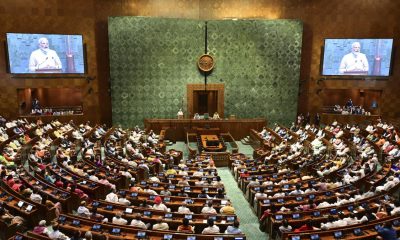Analysis
Iran defies sanctions to push forward with Digital Innovations

Mohammad Javad Azari Jahromi The Iranian ICT Minister
By Luyimbaazi Isah Katungulu
Digital transformation, e-government, knowledge economy, and space-based business are among the catch-phrases of technology in Iran during the Iranian calendar year 1397, ending on March 20.
Information technology and innovation ecosystem, as newly emerged approaches in Iran, promote efficiency and entrepreneurship, which seem attractive for both the young generation and the officials.
In mid-March, Information and Communication Minister Mohammad Javad Azari Jahromi announced that despite sanctions the ICT sector will flourish in the next Iranian calendar year 1398 (starting March 21).
Many entrepreneurs and officials eye innovation ecosystem and new technology as a method to transit Iran from the oil economy to a knowledge economy.
Digital transformation keeping pace with changing world
Digital transformation was one of the keywords frequently used by the ICT minister Azari Jahromi during the past year. He believed that e-government is a crucial phase, which should be passed to reach digital transformation.
Digital transformation is the transformation of business by revamping the business strategy or digital strategy, models, operations, products, marketing approach, objectives etc., by adopting digital technologies. This accelerates sales and growth of the business from end to end.
The document was planned to shed light to different aspects of DT including smart urban, administrative, executive and judicial management.
Technology eases everyday life of people
The technology achievements become tangible in today world. They ease everyday life with more efficient methods.
In July 2018, the ICT Ministry and the Ministry of Energy signed an agreement to boost job creation and improve efficiency in the field of water and electricity through technological advancement.
A pilot study was conducted in Moghan plain, northwestern Iran, and Qazvin plain, central Iran, resulted in a 50 percent decrease in water usage through smart irrigation. The figure is 15 percent in Fars province.
Some statistics about internet users in Iran

An Iranian Woman taking a selfie
Some organizations and ICT Ministry released statistics about internet and internet users in the country during the past year.
According to the survey, the internet user is defined as someone who has used the internet during the past three months and by this definition, 46,315,545 people are internet users in Iran.
According to the report, 72.8 percent of Iranian families have access to the internet, which means that 17,936,000 families benefit from internet nationwide.
A total of 17,216,000 families have access to a computer, which is 69.7 percent of the population.
Another survey, which was conducted two years ago, reported that 61.39 percent of Iranian families have access to the internet until the yearend of Iranian calendar year 1395 (ended on March 21, 2017).
Cybersecurity for children atop agenda
In mid-November, the ICT Ministry announced that it plans to introduce parental control applications.
According to a survey conducted by the ICT Ministry, only eight percent of Iranian parents monitor their children’s online activity.
The ministry held a festival named Koodakonline in March 2019 during which, it introduces apps for kids.
The festival acted as an incubator in the field of creating appropriate content for children and young adults
The kids’ launcher Nabat, children messaging app Medad, story and song application Touchstan and the application for children animation Aio Tune were named winners of the festival.
The ICT Ministry also plans to hold a festival on web series and online short films for children in spring 2019, he announced.
According to a report announced by the deputy education minister for training Alireza Kazemi in early December, about 20 million internet users out of 56 million users are below 18.
Satellites
In a speech in January 2019, ICT Minister announced that the satellites improve the standard of living, food and water resources security, which are the most important aims for the government.
Azari Jahromi said that Iran will not hold off development in the field of space technology and cannot wait for other countries to meet its needs.
In January 2019, Iran launched homegrown Payam satellite, however, the satellite’s carrier rocket could not reach the “necessary speed” and so neither reach the orbit, the information and communication technology (ICT) minister told the state TV.
Payam, a 90kg non-military satellite, was planned to be sent into a 500km orbit using domestically-made Safir satellite-carrier rocket.
Manufactured by the Amirkabir University of Technology, the image resolution of the Payam satellite is 45 meters and can stay in orbit for three years.
Later Azari Jahromi announced that Iran has spent 1.2 million euros for manufacturing Payam satellite over a period of ten years saying that the budget is not an expenditure but an investment, just like e-government, the remote sensing satellite will improve usage of water resources and methods of agriculture.
Nanotechnology achievements on the rise year on year
Recognizing the great importance of nanotechnology, Iranians have had boosted researches in the field year on year.
There are 257 companies active in this field, 33 percent of which working on nano-materials.
These companies have manufactured 376 different products using the nontechnology, showing that this is a field with huge economic and practical advantage.
There are 194 companies active in the field of nanotechnology in 2018 out of which, 60 percent were initiated as nanotechnology companies and the rest changed or developed as such companies.
With 9,662 articles and 5.81 percent of its share, Iran ranks 4th amongst the top 20 countries based on the share of nano-articles carried in 2018.
Approximately 166,000 nano-articles were indexed in the Web of Science (WoS) in 2018, comprising around 10% of the total. Among the different branches of science, chemistry, materials, and physics had respectively the largest shares of the indexed nano-articles.
Iran’s successes in biotechnology
In February 2019, the biotech development center (BioDC) announced that there are 146 biopharmaceuticals in the global market, out of which, 22 items are available in Iran which are monoclonal antibodies and recombinant proteins.
The Development of biotechnology can save $200-300 million annually in coming years.
Previously in October 2018, the BioDC released a report that medicine is on top of the list of exports of biotechnology products in Iran.
In July 2018, the vice president for science and technology Sourena Sattari announced that Iranian startups meet 98 percent of the domestic market’s need to biotechnology medicine.
Knowledge economy is a necessity
Knowledge economy and innovation ecosystem were catch-phrases of the vice president for science and technology Sourena Sattari during the past year.
In May 2018, the Health Ministry announced that Iranian knowledge-based companies operating in the field of health have supplied over 2,500 products to the domestic market and about 450 knowledge enterprises are now active in the field of healthcare products in the country.
It was announced that out of this number, 52 companies export their products with value more than 70 million dollars.
In April 2018, Iranian knowledge enterprises exported products valued at 450 million dollars during the past Iranian calendar year which ended on March 20, the vice president for science and technology announced on Saturday.
Bottom line
The technology and its application in everyday life bring transparency, comfort and time to us. However, this is all upon us how to use it and be aware of non-use of technology.
Iran is on the track to promote technology and innovation for a more easy life, creating jobs and opportunities for citizens and, of course, all of us can have own share in such a development. However, maybe we should write it on our resolution list for the New Year, to create and use technology tools and solutions and not let them use us. Happy Noruz
Comments


























